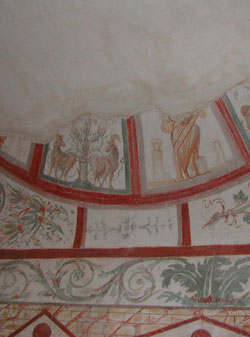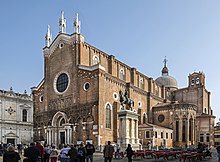
Feastday: June 26
Death: 362
Martyred priest of Rome. His head has been enshrined in San Silvestro in Capita, and his martyrdom was recorded in several legends that include miracles and prophecy.
This article is about the fourth-century Christian martyrs. For other uses, see John and Paul (disambiguation).
John and Paul (Latin: Ioannes, Paulus) are saints who lived during the fourth century in the Roman Empire. They were martyred at Rome on 26 June. The year of their martyrdom is uncertain according to their Acts; it occurred under Julian the Apostate (361–3).
Hagiography
In the second half of the fourth century, Byzantius, the Roman senator, and Saint Pammachius, his son, fashioned their house on the Cælian Hill into a Christian basilica. In the fifth century the presbyteri tituli Byzantii (priests of the church of Byzantius) are mentioned in an inscription and among the signatures of the Roman Council of 499. The church was also called the titulus Pammachii after Byzantius's son, the pious friend of St. Jerome.
 The original Roman house below the present-day Basilica of Santi Giovanni e Paolo
The original Roman house below the present-day Basilica of Santi Giovanni e Paolo
In the ancient apartments on the ground-floor of the house of Byzantius, which were still retained under the basilica, the tomb of two Roman martyrs, John and Paul, was the object of veneration as early as the fifth century.
The Sacramentarium Leonianum already indicates in the preface to the feast of the saints, that they rested within the city walls ("Sacr. Leon.", ed. Feltoe, Cambridge, 1896, 34), while, in one of the early itineraries to the tombs of the Roman martyrs, their grave is assigned to the church on the Cælian (De rossi, "Roma sotterrania", I, 138, 175).
The titulus Byzantii or Pammachii was consequently known at a very early date by the names of the two martyrs (titulus SS. Joannis et Pauli). That the two saints are martyrs of the Roman Church is historically certain; as to how and when their bodies found a resting-place in the house of Pammachius under the basilica, we only know that it certainly occurred in the fourth century. The year and circumstances of their martyrdom are likewise unknown.
Acts
According to their Acts, the martyrs were eunuchs of Constantina, daughter of Constantine the Great, and became acquainted with a certain Gallicanus, who built a church in Ostia. At the command of Julian the Apostate, they were beheaded secretly by Terentianus in their house on the Caelian Hill, where their church was subsequently erected, and where they themselves were buried. Three Christians who were ministering to them were also executed and buried nearby: Crispus, Crispinianus, and Benedicta.
The rooms on the ground-floor of the above-mentioned house of Pammachius were rediscovered under the Basilica of Santi Giovanni e Paolo in Rome. They are decorated with important and interesting frescoes, while the original tomb (confessio) of Sts. John and Paul is covered with paintings of which the martyrs are the subject. The rooms and the tomb form one of the most important early Christian memorials in Rome.
Since the erection of the basilica, the two saints have been greatly venerated, and their names have been inserted in the Canon of the Mass.
Their feast is kept on 26 June.
The Acts of Saints John and Paul are also connected with the legend of St Bibiana, which has no historical claim to belief.
Veneration
 The church of San Zanipolo
The church of San Zanipolo
The basilica of Santi Giovanni e Paolo in Rome is dedicated to them, as is the Basilica di San Zanipolo in Venice ("Zanipolo" being Venetian for "John and Paul").
Saints John and Paul's Day
The Lüneberg manuscript (c. 1440–1450) mentions the day of John and Paul in an early German account of the Pied Piper of Hamelin:
In 1284 on the day of John and Paul on 26th June
130 children born in Hamelin were led away
by a piper [clothed] in many colours
to [their] Calvary near the Koppen, [and] lost'.
Campania Town
| This section does not cite any sources. (March 2017) |
A small village next to Caiazzo in the Campania region of Italy is named Ss. Giovanni e Paolo in honor of these martyrs. Many residents of this village bear the family name "San Giovanni," as do the descendants of immigrants to the United States from this village (in particular, in Michigan, New York, and Florida).





